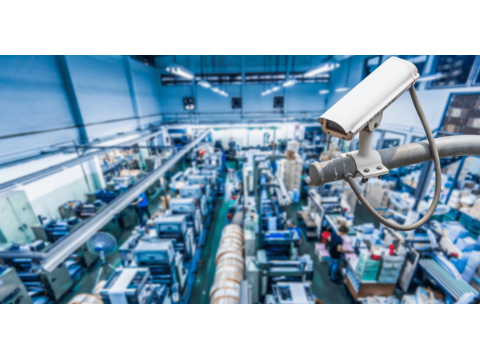Industrial Surveillance Systems – Ensuring Workplace Security
Surveillance systems in industrial facilities are critical for maintaining security, improving productivity, and ensuring safety across complex operations. With vast areas, multiple buildings, and intricate workflows, effective video monitoring offers an essential layer of protection.
Objectives of Industrial Surveillance
Prevent Losses and Violations
- Discourage unauthorized activities and theft.
- Ensure compliance with safety standards and production protocols.
Post-Event Analysis
- Investigate incidents with video evidence.
- Resolve disputes and identify responsible parties effectively.
Optimize Operations
- Analyze workflows to improve efficiency.
- Coordinate remote teams with two-way video communication.
Customer Insights and Marketing
- Study consumer interactions with products.
- Utilize data for improving layouts and service efficiency.
Key Areas for Surveillance
Production Areas
- Monitor machinery for operational efficiency and safety compliance.
- Identify potential malfunctions and mitigate risks promptly.
Warehouses
- Oversee storage areas, loading docks, and surrounding spaces.
- Prevent theft and ensure smooth logistical operations.
Administrative Buildings
- Detect and deter misuse of confidential information.
- Resolve disputes between employees and visitors.
Entry Points and Parking Areas
- Track vehicle and personnel movements.
- Verify vehicle dwell times and route adherence.
Perimeter Security
- Monitor boundary areas to prevent unauthorized access.
- Focus on gates, fire exits, and parking lots for complete coverage.
Implementation Strategies
Camera Selection
- Indoor Cameras: Ideal for administrative and warehouse interiors.
- Outdoor Cameras: Weather-resistant models for perimeter and entry monitoring.
Strategic Placement
- Position cameras to avoid blind spots and overlap critical zones.
- Use wide-angle lenses in open areas for broader coverage.
Technology Integration
- License Plate Recognition (LPR): Automate vehicle access tracking.
- Facial Recognition: Enhance entry security with advanced analytics.
Remote Monitoring
- Enable real-time surveillance via mobile apps and cloud platforms.
- Integrate systems for centralized data analysis and reporting.
Benefits of Industrial Surveillance
Enhanced Safety
- Reduce workplace accidents by ensuring adherence to safety protocols.
- Proactively identify hazards with real-time monitoring.
Improved Productivity
- Track workflow bottlenecks and implement improvements.
- Monitor employee performance to maintain high operational standards.
Cost Efficiency
- Minimize losses from theft and damage.
- Reduce insurance premiums with documented safety measures.
Conclusion
Industrial surveillance systems are indispensable for modern enterprises aiming to enhance security and streamline operations. By strategically deploying cameras and integrating advanced technologies, businesses can ensure workplace safety, prevent unauthorized access, and improve overall efficiency.
Investing in tailored video monitoring solutions not only safeguards assets but also fosters a productive and secure work environment.

